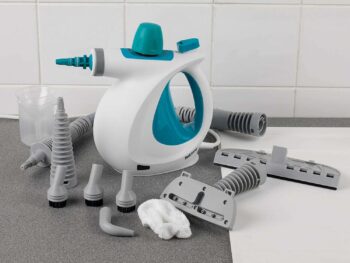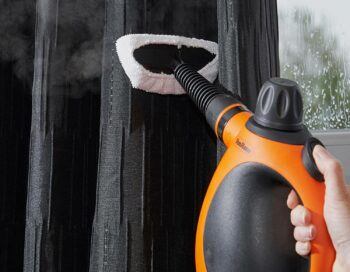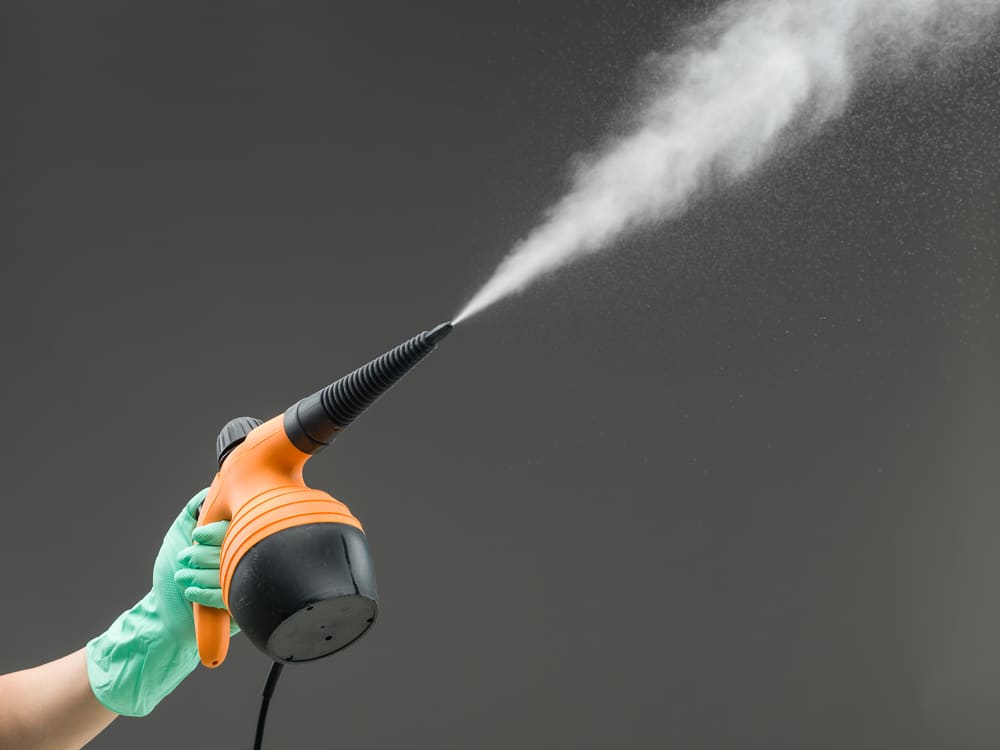Steam cleaners provide an excellent way to quickly destroy dirt, grime, bacteria and microscopic bugs that lurk in your home. Steam cleaners are generally simple to use, but if you’ve just purchased your first ever model or haven’t used one for some time, it makes sense to go over the basics before you get stuck in. To help you get the best results from your steam mop, here’s our step by step guide on how to use a handheld steam cleaner.
Handheld steam cleaners are extremely versatile, suitable for cleaning a wide variety of household items, features and fittings. Read through the following tips for a hygienic and thorough clean with next to no effort required.
Preparation is Key
Your handheld steam cleaner provides a highly effective solution for sanitising your home, killing bacteria and dust mites and lifting stains, without the need for any harsh chemicals. However, in order for your steamer to do its job, you need to clean thoroughly before getting out your steam cleaner.
Whatever you’re thinking of cleaning with your portable device, be it your mattress or your floor, you’ll need to completely vacuum the entire area first to get the best results. Your steam cleaner will lift dirt and kill pathogens, but it won’t remove the dirt. It’s best to get rid of any dust and other particles prior to steam cleaning.
You’ll also want to get any attachments and steam pads or accessory cloth covers ready for use. So gather everything you’ll need before you fill up your machine and plug it in.
View this post on Instagram
Is There Anything I Should Not Use My Steam Cleaner On?
Your handheld steam cleaner will be suitable for cleaning most household items, however, there are a few things that you will want to avoid cleaning with it.
- Laminate flooring – although laminated flooring is protected and you can use regular cleaning methods, the high-pressured steam produced by your handheld steam cleaner can penetrate deep down into the wood below which could cause rot.
- Antiques – do not use a steam cleaner on your antique furniture. Steam cleaners are very powerful and can easily strip any protective or decorative finishes.
- Fragile fabrics – fabrics that cannot take extreme heat are best avoided. If you desperately want to steam clean a fabric but have your doubts, try steaming it on low from a distance in an inconspicuous area first.
- Painted materials – paint is easily damaged by powerful jets of steam. If you try steam cleaning a stain on your wall, you may end up stripping an entire area of paint.
- Anything that is damaged by water – cardboard, stickers, varnish, non-fast colours – if it’s an item you would hesitate to wet clean, then steam cleaning is going to damage it. If it really is a case of clean it or bin it, try steam cleaning it rapidly from a distance.
Which Steam Cleaner Attachments For Which Item?
 If you are removing stubborn stains from a small area with a hard surface, such as grout between tiles, grease around your kitchen hob, or build up around your taps, use the jet nozzle for a highly concentrated powerful spray of steam.
If you are removing stubborn stains from a small area with a hard surface, such as grout between tiles, grease around your kitchen hob, or build up around your taps, use the jet nozzle for a highly concentrated powerful spray of steam.
For floors, you’ll want to use the dedicated floor tool. Its large rectangular shape can accommodate a cleaning pad and makes cleaning large areas much faster. Windows also benefit from a specialised attachment in the form of a traditional squeegee that attaches directly to your handheld steam cleaner.
For upholstery, you can use a medium-sized brush tool or nozzle, depending on the area to be cleaned and any hard-to-reach places. You may like to use a brush cloth cover over the attachment to help absorb moisture and remove dirt.
Awkward or tight areas can benefit from an angled attachment, especially good for getting into corners, grout lines, the edge of shower doors and cleaning around bathroom fittings. Some handheld steam cleaners come with a flexible wand that makes cleaning around items much easier.
Our advice is to try out all of the attachments that come with your steam cleaner. While different nozzles are designed with different cleaning tasks in mind, you may find a new use, or that a particular one works best for your needs.
What Can I Put in My Steam Cleaner?
 As we are so used to using chemicals to clean our homes, a lot of people worry that they need to add some kind of disinfectant or other cleansers to their steamer for best results. Your steam cleaner will kill over 99% of bacteria through the high temperature of the steam it emits.
As we are so used to using chemicals to clean our homes, a lot of people worry that they need to add some kind of disinfectant or other cleansers to their steamer for best results. Your steam cleaner will kill over 99% of bacteria through the high temperature of the steam it emits.
When you use the steam cleaner, there is no need to add any chemicals. Doing so could, in fact, damage your steam cleaner and the surfaces you use it on. Certain cleaning chemicals can release toxic fumes when heated too high or even explode. Use distilled water or tap water only in your steam cleaner.
If you have got behind on your home cleaning chores and want to give your house an extra deep clean using a disinfectant, then we recommend using traditional methods. You can then follow up and use a steam cleaner for all routine cleaning. Steam cleaning is an excellent way to keep your home hygienically clean without exposing yourself and your loved ones to potentially dangerous chemicals.
Keep Your Steam Cleaner Moving
Once you have your steam cleaner all set up, filled with water, and heated up (tip: fill with hot water to save time), it’s time to get cleaning. Most handheld steam cleaners have a steam button or trigger that you hold down to release steam.
When using your steam cleaner, keep it permanently moving without resting on one spot for too long. If you are cleaning a patch with stubborn dirt and grime, the most effective way is to make several passes over the area rather than holding your cleaner stationary in one place.
Take care with any fragile materials, deep pile carpets or heavily worn fabrics. A jet of steam can be powerful. Hence, if you have any worries about suitability, try a wide head and steam from afar, preferably starting in an inconspicuous area. You should also be aware that because it has such a high heat output, it’s advised to steam at a distance around porcelain bathroom fixtures that can be adversely affected by the extreme temperature.
Swap Dirty Pads/Cloths
 If you’re using a steam cleaner floor pad or accessory cloth cover, make sure that you change it as soon as it becomes dirty. While your steam cleaner will still get to work sanitising your floors, upholstery or fittings, if you carry on with a dirty cloth, you are essentially just spreading the dirt that it has lifted around.
If you’re using a steam cleaner floor pad or accessory cloth cover, make sure that you change it as soon as it becomes dirty. While your steam cleaner will still get to work sanitising your floors, upholstery or fittings, if you carry on with a dirty cloth, you are essentially just spreading the dirt that it has lifted around.
Steam cleaner floor cloths are inexpensive and readily available for all models, so make sure you have plenty of spares available. They can go in the wash with your towels or other cleaning cloths and are generally hard-wearing. Just make sure that you do not use any fabric softener on them as this can adversely affect their absorbency levels.
Wipe and Allow for Drying Time
The biggest mistake that many people make when steam cleaning is not wiping up sufficiently afterwards. Remember, your steam cleaner will kill germs and lift dirt, but it’s incapable of removing these things. Therefore, you will need to wipe your item clean or use a cloth cover or floor pad depending on the task at hand.
While your floor, for example, will dry much quicker with hot steam than a bucket and mop, don’t forget that steam cleaning does still result in quite a bit of moisture. If you are cleaning soft furnishings, such as your mattress, sofa, or rugs, don’t forget to allow for sufficient drying time. Several hours should normally suffice, but be prepared to leave some items for longer if necessary.
Storing Your Steam Cleaner
When you’ve finished your cleaning job, make sure that you unplug your steam cleaner straightaway. It will automatically lock when it’s under pressure, so give it plenty of time to cool down. You could use this period to wipe down your freshly cleaned items or to rearrange them so they dry more efficiently.
Once your steam cleaner has cooled, remove your cleaning pad or cloth. Leaving a damp cloth attached to your machine until its next use is unhygienic. This can result in the growth of mould and bacteria. So, always remove your pad and put it in with the next suitable wash.
Remove any attachment tools such as your brush attachment, steam nozzle, jet nozzle or carpet glider. If necessary, rinse them off and give them a quick wipe over. Next, drain the tank of your steam mop. This will help to prevent any build-up and ensure that your machine lasts longer. If necessary, descale your machine from time to time following the manufacturer’s instructions. Using distilled water is highly recommended as it helps to keep your steamer free from limescale and in good working order.
Summary
Steam cleaners are very easy to use and highly effective. They also require very little maintenance, and you won’t have to pay out for expensive chemical cleaners, making them both eco and wallet-friendly. Provided you follow our cleaning tips in our step by step guide on how to use a handheld steam cleaner, you’re sure to get off to a great start cleaning your home.
Whatever you need to steam clean, be sure to read the information provided with both the steamer and the item you are cleaning. There are many ways to use your steamer, so let us know if you have any tips and tricks!
Additional Resources
- What Can You Clean with a Handheld Steam Cleaner
- How Does a Pressure Washer Work
- How to Take Apart a Bissell ProHeat Carpet Cleaner
Kelly is an expert in consumer product research, which is very important when it comes to finding the most useful and aesthetically pleasing items for your home. This became her passion after finding it very time-consuming to wade through all the product information online.
She has a keen attention to detail which she brings to her articles, Kelly’s goal is to help you find what you need without spending too much time searching for it.

